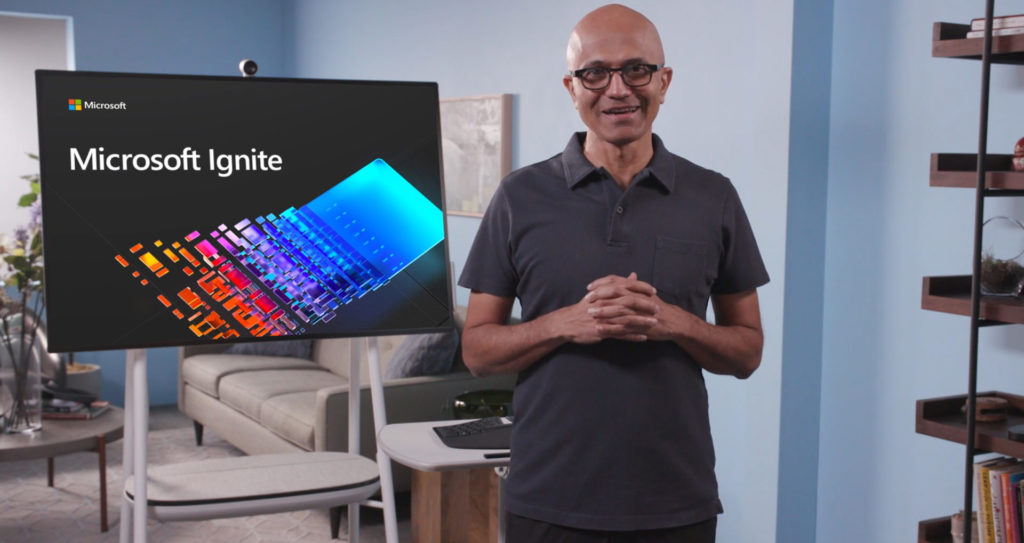When Microsoft talks, tech people listen — especially those who run networks, oversee IT, or provide IT services to others. But it appears not everyone is hearing what the tech giant is saying. Amy Babinchak, who runs a successful MSP, knows exactly what Microsoft is telling her and all others who work in information technology: Keep learning or fall behind. Amy shares her knowledge and insights in this excellent entry in our 20 Best of 2020 series.
Microsoft has now held both its Inspire and Ignite conferences. Inspire is marketing-focused toward Microsoft’s partners while Ignite is more technical. With both conferences, Microsoft has painted a vision of the future of business. Microsoft presents its tech, its vision, but sometimes you have to read between the lines too. Here is what I think Microsoft is saying to SMBs, IT professionals, and owners of MSBs like me.

Fluidity of work
In several sessions at Ignite 2020 and in Satya Nadella’s keynote address, there was a lot of talk about the fluid movement of working from the office to working from home as being the long-term condition of normal work life following the pandemic. I also recently read that by 2025, 70 percent of all workers will be of the millennial generation. A recent article in the Wall Street Journal talked about the vast number of new businesses that have started in 2020. The numbers are record-setting for both sole proprietorships and businesses with employees. We are in times of great change indeed, and as I keep saying, the pandemic has shifted us into #fastforward. Microsoft also estimated that each month since the beginning of the pandemic has brought us a year’s worth of innovation. Together, this information is trying to tell us something. What does this mean for IT professionals and for existing SMBs? What technology moves do SMBs need to make to position themselves for this reality that Microsoft is talking about?
Education

While many people resist change, those who adopt continual education are less resistant to change. This is not a time to be settled in knowledge. As technology changes, businesses and employees within those businesses who are not competent in new ways of doing things won’t be able to compete with these newly formed companies that are up and coming and loaded with tech-savvy millennials. Some will simply ride into the sunset, staying with what they’ve always done, but those who aren’t approaching the sunset years should expect to make significant changes.
As IT professionals, we need to step up our game too. My staff takes in about 300 hours of training each year just to stay on the expert side of technology. Education has become just one of the regular tasks that we do every week. In addition, I’ve hired a trainer to help clients with automation and to deliver custom training so clients can learn how to do things that are unique to their business and not covered in generic online training courses they might take. At the moment, this makes my MSP unique, but I expect that most others will follow suit soon if they haven’t already. As we move further into this new era, I expect that all of my technical staff will be taking on training activities as a regular part of their duties. IT professionals may not have thought of themselves as trainers but showing the end-user how to perform a task has always been part of their duties. What is different now is that they need to know about making user activities more efficient and how to automate those tasks.
Security and privacy
I recently wrote about how when we think about privacy, we need to take into account not just our own privacy but how we manage the data of others. Thinking along this line is new for most businesses. To help businesses with this important task, Microsoft demonstrated trainable labels that can automate data retention and privacy. Policies can be applied against those labels to make sure that data you don’t want to be responsible for is deleted after a specified time, encrypted, and restricted from external sharing. This is a momentous shift for end-users than it sounds at first. While some data protection and data privacy can be managed through policies and rule sets, it’s really a seismic shift in who is responsible for data privacy and security. It is putting that responsibility for maintaining data protection into the hands of end-users. IT will set policy, but ultimately the responsibility isn’t theirs anymore. Much like we have anti-phishing policies set by IT, it’s the responsibility of the end-user to know how to identify a phishing email and not click it. The end-user will be taking more responsibility in the world of security and data privacy, and they’ll need to know how to do it.
Meanwhile, MSPs are being taken to task for not implementing enough security to protect clients from ransomware because security hasn’t been a high priority. Security was an important subject, but it was not a mandate. Businesses hit by ransomware are saying that MSPs should have insisted that they put more protections into place. But most MSPs do not have security staff; they have generalists. Further, MSPs are usually outsourced part-time administrators, not present at all times to serve as the scam and security police. In addition, many MSPs and internal IT staff take the position that security measures cause more support tickets, and more support tickets take more time and cost more money. Microsoft has been responding to this by implementing new policies by default that enforce security standards, and they announced Microsoft 365 Lighthouse, which visualizes security, configuration, and compliance alerts so MSP staff can easily see across the clients and take action when the alerts occur. Secure-by-default is making a comeback because the evidence says that IT just wasn’t doing the job to configure security features.
This is where reading between the lines needs to occur. Microsoft finds itself for the first-time managing desktop computers across many clients. They are in the MSP business with their Managed Desktop program. Aimed at enterprises, Microsoft Managed Desktop is really the same work that MSPs are doing in the SMB market. Will it expand to smaller businesses? Time will tell, but certainly, Lighthouse is a tool that Microsoft needs to make its Managed Desktop program work efficiently. Why didn’t they just use one of the existing remote monitoring and management tools? Because none of them were designed to manage a cloud-enabled world. Lighthouse isn’t going to compete with existing RMM tools. It’s going to usher in a new era of them. Between the lines, why is Microsoft implementing secure-by-default policies and developing a new RMM tool? Because they need the tools for their Managed Desktop program. Luckily, the rest of us get to use them too.
Work from home

What about that fluid movement from office to working from home? That’s a huge change too. Millennials complained about the rigidity of work as they started to enter the workforce, and now the pandemic has delivered the flexibility in work/life that they desired. You can bet that the new businesses that they form will be designed with this flexibility from day one. The holiday on college loan repayment has paid huge dividends freeing up the young to take the risk of starting a new business.
What this means is that we have to redesign networks to support the fluid movement of work. To be productive, the network must provide access to all data and applications wherever the person is working from and on the type of device that they have available. Microsoft announced Universal Print, which allows printing back to the office printer for access to those specialty devices they might not have at home. But we’ll need to implement robust device and data policies that protect data no matter where it goes and security and productivity environments for those home offices too.
IT is responsible for implementing this, but we play another role too. As the user moves around from place to place and from device to device, we need to make sure that they are always working from secure, productive environments. We need to let business management know what it’s going to take to make that happen. More Intune device configuration policies, mobile devices, secured home offices, devices that are under management both in the home and in the office. And data that remains under management when it moves from place to place too. Microsoft has made the tools available. Now we just have to skill up enough to implement them and make sure that the users we care for get skilled up too. This is a partnership between IT and end-user that is about to get very cozy.
Microsoft’s message to SMBs: It’s really pretty simple
What is Microsoft saying to SMBs and those who manage their networks? We had better get training — employees in small and medium-sized businesses and those in IT. We’re partners, and the way that we both do our work is changing and changing fast.
Featured image: Shutterstock




Insightful article. I’ll note you often hear the emphasis on training from big companies, wanting to ensure their teams stay current. It will be interesting to see how small companies and small IT staffs cope with doing the job in front of them, while preparing for the job to come.
I believe this sentence sums it up pretty well: “While many people resist change, those who adopt continual education are less resistant to change. This is not a time to be settled in knowledge. “
Thanks Fernando